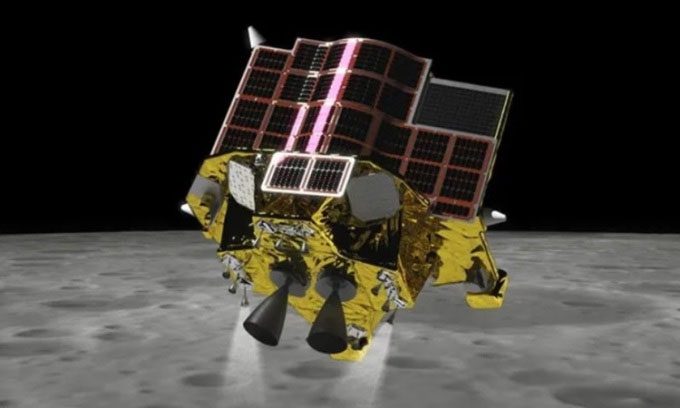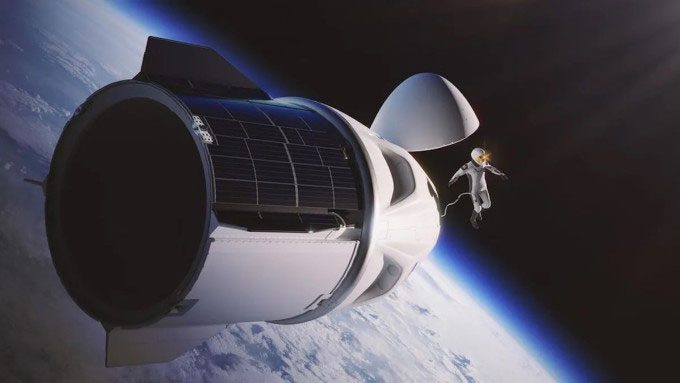The year 2024 will continue to witness efforts to explore the Moon, test flights of new vehicles, and the emergence of new records.
Japan’s Lander Aims to Touch Down on the Moon

Simulation of the SLIM spacecraft preparing to land. (Photo: JAXA).
The Japan Aerospace Exploration Agency (JAXA) launched the Smart Lander for Investigating Moon (SLIM) in September 2023. The spacecraft entered lunar orbit in December and is expected to land inside the Shioli crater on the Moon on January 19. The SLIM mission aims to demonstrate the capability to land with extreme precision, within 100 meters of its target. If successful, this will mark Japan’s first successful lunar landing, making it the fifth country to achieve this feat, following the Soviet Union, the United States, China, and India.
Starship Launch System Prepares for Third Flight
SpaceX’s Starship launch system is gearing up for its third flight, IFT-3, scheduled for the first quarter of 2024. This flight aims to validate key technologies for future lunar and interplanetary missions. Starship has undergone two test flights in 2023, neither reaching orbit. SpaceX has contracted with NASA to develop a lunar lander version of Starship by 2025, suggesting that the vehicle may launch several more times this year. Starship could also be developed as a crewed vehicle for future missions to Mars.
Boeing’s Crewed Spacecraft Launch
The first crewed test flight of Boeing’s Starliner spacecraft is planned for mid-April. This 8-day mission will take astronauts to the International Space Station (ISS). Starliner consists of a reusable crew module and a disposable service module. The spacecraft is designed to transport crews to low Earth orbit and will support NASA’s Commercial Crew Program. During its first test flight, Starliner will launch into space using a ULA Atlas V rocket.
First Private Extravehicular Activity Mission
The Polaris Dawn mission is part of the Polaris Program, a series of launches contracted by billionaire Jared Isaacman, set to launch as early as April 2024. In this mission, SpaceX’s Crew Dragon will take Isaacman and three others to low Earth orbit for several days. If successful, the mission will set multiple records, including the first private spacewalk and the highest spacewalk ever recorded.

The Polaris Dawn mission may host the first private spacewalk. (Photo: Polaris Program).
China Launches Lunar Sample Return Mission
The Chang’e 6 mission is scheduled to launch in May 2024 with the goal of bringing lunar samples back to Earth. This noteworthy mission will collect rock and soil samples from the far side of the Moon, specifically from the South Pole-Aitken Basin. This area is believed to have abundant water ice reserves, and scientists have never retrieved samples from here. Even if the ice has melted by the time Chang’e 6 returns to Earth, studying the samples will provide valuable insights into the South Pole-Aitken Basin and its potential as a water source for future astronauts.
American Spaceplane Ready for Launch
NASA and American company Sierra Space plan to launch the Dream Chaser spaceplane in 2024 using a ULA Vulcan Centaur rocket. Dream Chaser is a reusable private spaceplane designed to transport cargo and astronauts to low Earth orbit. The first uncrewed flight of the spaceplane will be directed towards the International Space Station (ISS). Dream Chaser is expected to carry over 3,500 tons of cargo for this mission. It will also be able to transport experiment samples, waste, and other supplies back to Earth from the ISS. If successful, Dream Chaser will play a crucial role in NASA’s commercial resupply program.
Mission to Search for Life on Jupiter’s Moon
NASA plans to launch the Europa Clipper spacecraft to explore Europa, Jupiter’s icy moon, one of the leading candidates for harboring life in the solar system, in 2024. The Europa Clipper is expected to launch in October 2024 using SpaceX’s Falcon Heavy rocket and arrive at Jupiter by April 2030. Upon arrival, this car-sized spacecraft will use radar instruments to map Europa’s ice shell and study what lies beneath, where vast subsurface oceans may exist.

Simulation of the Europa Clipper spacecraft. (Photo: NASA/JPL-Caltech).
Artemis 2 Mission to Return Humans to the Moon
The NASA Artemis 2 mission, expected to last 8 days, aims to bring astronauts back to the Moon after nearly 50 years. The mission will utilize the Space Launch System (SLS) rocket and the Orion spacecraft, with a launch date as early as November 2024. The spacecraft will carry four astronauts on a flyby of the Moon. Flying at an altitude of approximately 10,300 km on the Moon’s far side, Artemis 2 will become the first crewed mission to venture beyond low Earth orbit since the Apollo 17 mission in 1972.


















































